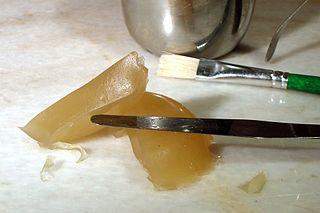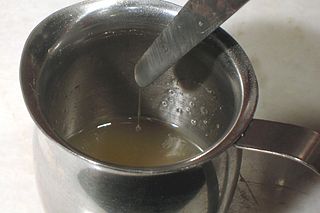Note: This is a classic reprint from NEWS #011, June 1993. The author is recorded as Paul Gregson.
Hide Glue
Preparation

|
The dry pearls or powder may be prepared by weight ratio to water and for all working grades in the range 30% to 40%.
- Russian 30%
- Cabinet 35%
- Joiners 40%
(all maximum).
It may be more easily prepared by, for example, taking a sample of cold water and mix in desired quantity of glue, stir to get full wetted surface. Allow to stand about ½ hour, (or when pearls are near ‘off white’, with small buff centres) and pour off excess water, then heat in glue pot.
Once it obtains working temperature mix with paddle or brush the entire contents and add HOT water if required to give a steady stream without ‘splutters’ off the brush when it is a couple of inches off the surface.
Use
- Don't try and do the whole job by yourself all at once or without having a dry run thus enabling clamps and furniture members to be laid out in sequence. A large job may require 2 or 3 workers - it always did and always will. For example, a chair back frame and front rail/legs are glued up one day and the side rails added on another day - the whole to stand approx. 7 days for curing.
- If using toothing planes make certain cut fibres are clear of the Joints to be glued
- Size (1:10 water) -porous timbers or veneers prior to use - allow to dry and then glue normally.
- Heat cold joints with air gun or work in warm environment.
- Make sure all joints are sound fitting - do not believe in gap filling glue (e.g. a chair should stand up by itself - dry jointed without glue).
- Use a good mercury thermometer if the temperature is uncertain.

|
Factors Affecting Adhesive Strength
- Concentration of the prepared glue.
- Temperature of the applied glue - union must be made before jelling.
- Temperature used to heat the glue (must not exceed 70°C
- Porosity of the timber (size as required).
- Trueness of the joint (good cabinetmaking skills and clear of fibres).
- Temperature of the wood. (use a heat gun as required).
- Curing time allow up to 7 days for the glue to harden and lose moisture. Joints under stress (hopefully minimum) should be left under clamps for a few days.
Remember
Gluing is not the job for the apprentice – it is the job both in the preparation and correct application for the craftsman. After all it is the job that will make or fail the job.
Some Don’ts
Don't:
- Buy cheap or stale glue.
- Use dirty water (preferably distilled).
- Reheat the glue, change every day or maximum 32 hours if in an electric pot left on overnight
- Add glue to stiffen a batch
- Use dirty utensils or brushes.
- Boil the glue.
Do:
- Keep a clean area for gluing it is a precise activity. Go about your work with confidence and mobility. If a mistake is made it can always be disassembled, flushed off, dried and reglued.
- Think about using hide glue in your masterpieces. Its use makes certain that they will survive in the community longer.
Good Luck.
Paul Gregson
